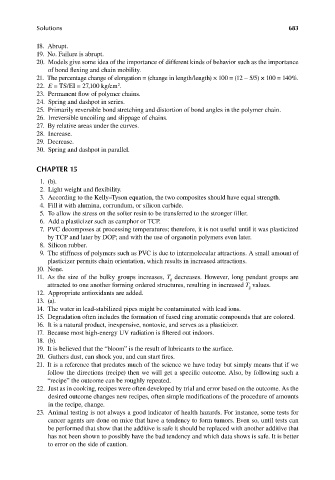Page 720 - Carrahers_Polymer_Chemistry,_Eighth_Edition
P. 720
Solutions 683
18. Abrupt.
19. No. Failure is abrupt.
20. Models give some idea of the importance of different kinds of behavior such as the importance
of bond flexing and chain mobility.
21. The percentage change of elongation = (change in length/length) × 100 = (12 − 5/5) × 100 = 140%.
2
22. E = TS/EI = 27,100 kg/cm .
23. Permanent flow of polymer chains.
24. Spring and dashpot in series.
25. Primarily reversible bond stretching and distortion of bond angles in the polymer chain.
26. Irreversible uncoiling and slippage of chains.
27. By relative areas under the curves.
28. Increase.
29. Decrease.
30. Spring and dashpot in parallel.
CHAPTER 15
1. (b).
2. Light weight and fl exibility.
3. According to the Kelly–Tyson equation, the two composites should have equal strength.
4. Fill it with alumina, corrundum, or silicon carbide.
5. To allow the stress on the softer resin to be transferred to the stronger fi ller.
6. Add a plasticizer such as camphor or TCP.
7. PVC decomposes at processing temperatures; therefore, it is not useful until it was plasticized
by TCP and later by DOP; and with the use of organotin polymers even later.
8. Silicon rubber.
9. The stiffness of polymers such as PVC is due to intermolecular attractions. A small amount of
plasticizer permits chain orientation, which results in increased attractions.
10. None.
11. As the size of the bulky groups increases, T decreases. However, long pendant groups are
g
attracted to one another forming ordered structures, resulting in increased T values.
g
12. Appropriate antioxidants are added.
13. (a).
14. The water in lead-stabilized pipes might be contaminated with lead ions.
15. Degradation often includes the formation of fused ring aromatic compounds that are colored.
16. It is a natural product, inexpensive, nontoxic, and serves as a plasticizer.
17. Because most high-energy UV radiation is filtered out indoors.
18. (b).
19. It is believed that the “bloom” is the result of lubricants to the surface.
20. Gathers dust, can shock you, and can start fi res.
21. It is a reference that predates much of the science we have today but simply means that if we
follow the directions (recipe) then we will get a specific outcome. Also, by following such a
“recipe” the outcome can be roughly repeated.
22. Just as in cooking, recipes were often developed by trial and error based on the outcome. As the
desired outcome changes new recipes, often simple modifications of the procedure of amounts
in the recipe, change.
23. Animal testing is not always a good indicator of health hazards. For instance, some tests for
cancer agents are done on mice that have a tendency to form tumors. Even so, until tests can
be performed that show that the additive is safe it should be replaced with another additive that
has not been shown to possibly have the bad tendency and which data shows is safe. It is better
to error on the side of caution.
9/14/2010 3:44:17 PM
K10478.indb 683 9/14/2010 3:44:17 PM
K10478.indb 683

